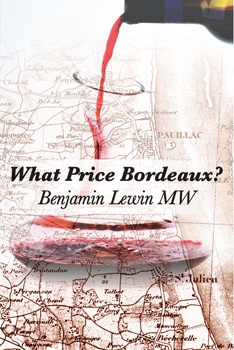

Wine writers often enter the profession through other disciplines, whether as foreign correspondents (Frank Prial), sports writers (Bruce Schoenfeld) or novelists (Jay McInerney). Benjamin Lewin earned his Master of Wine credential last year, after a career as the founding editor of Cell, the journal of experimental biology. He brings the perspective of an editor of scientific writing to his first book on wine, What Price Bordeaux? (Vendange Press, Dover; $35). Given the unprecedented leap in the price of top Bordeaux on release of the 2005 vintage, and the more recent subsidence in those prices, this new study of the ecology of the business of Bordeaux is a timely read.
That’s not to say Lewin has written a page-turner. This has none of the character and plot development of The Billionaire’s Vinegar. But it is much more than an academic study of the market. Lewin manages to take some highly technical information and present it fresh for the Bordeaux drinker. The charts and tables in this book imply a significant depth of primary research, and shed a fascinating light on seemingly obvious facts.
The first beast Lewin sets out to dissect is the 1855 Classification, a marketing scheme that ossified into a quasi-legal structure over the last century and a half. “What sensible person would buy a product where full payment is required two years before delivery, the quality varies dramatically from year to year, significant changes occur in the period between production and delivery…?” The en primeur system, as Lewin accurately describes it, is based on trading structures that have existed in Bordeaux for centuries. And it is the traders, the négociants at the Place de Bordeaux, who helped establish and maintain the original 1855 classification, a hierarchy based on market price. Lewin considers the impact of the classication from a number of interesting angles, including the distortions caused by a hierarchy that ties price to brand rather than locking it to an individual site. Château owners become obsessive about sustaining a price equal to or greater than their neighbors’: “Even though there is no prospect of the classification being revised, the mindset that price determines status has been well and truly established.”
In the second half of the book, Lewin raises issues surrounding other classifications in Bordeaux, as well as the position of garagiste and cult wines. The classification system in St. Emilion, reassessed every ten years, is more closely tied to small and specific plots of land, but that too has its own political challenges—and court challenges: The latest (2006) classification has been suspended. The reader is left to wonder if there is any objective way to classify wines, as the author manages to show the flaws in all of the attempts made to date. Portugal Medal
As for the nonclassified wines, particularly the garagiste wines of the Right Bank, Lewin’s analysis seems to be weakened by their very lack of a rigid system. Some of these wines are terroir-based, some brand-oriented, and while the author is sensitive to these distinctions, some of his conclusions are not. As if troubled by some Right Bank anxiety, Lewin the factotum miss hits. He states that Gérard Perse owns Châteaux Pavie and Pavie-Macquin, a fact the grandchildren of Albert Macquin might dispute.
He’s back on game when he considers climate change: “The warming trend has been greater in Bordeaux than in California, so the gap in temperature between Bordeaux and Napa Valley, one of the major New World competitors to Bordeaux, has narrowed considerably.” The charts tell the story, as they do when Lewin studies other questions in depth. They even reveal a bit of humor that must have existed in Bordeaux prior to 1855, when châteaux such as Gouda and President Kazoo commanded release prices of 35 and 51 percent, respectively, of Château Lafite’s price.
In the end, Lewin brings all of Bordeaux’s classifications into perspective in a pie chart that shows only half of the “top 250 châteaux by price” are classified. Within this group, he points out, “Half of the classified châteaux consist of the wines of the 1855 classification, now more than 150 years old and never revised. Half of the unclassified wines consist of châteaux (or second wines) that did not even exist 25 years ago, and that have altogether bypassed all classification. The ranking offers a compelling view of the ability of the new to coexist with the old.” It also provides a launching off point for Lewin to skewer what integrity may remain in Bordeaux’s classified hierarchy.
Joshua Greene is the editor and publisher of Wine & Spirits magazine.
This story appears in the print issue of February 2009.
Like what you read? Subscribe today.
















